|
Introduction
The species in the
genus Paracheilinus are appropriately called flasher
wrasses (or simply flashers), and they are very closely related
to fairy
wrasses of the genus Cirrhilabrus.
Dr. John E. McCosker is the ichthyologist credited for originally
naming Paracheilinus as the Flasher Wrasse, and this
common name is derived from their grandeur "flashing"
behavior observed during courting or mating where the male
will make quick, exaggerated lateral moves while intensifying
his colors and erecting his fins to attract a mate. The genus
is composed of 14 species that are found in the Indo-West
Pacific Oceans, from the Red Sea and the Kenyan coast to Samoa,
and from southern Japan and the Marshall Islands to the Great
Barrier Reef. They have been kept by many aquarists around
the world, but the genus was relatively unknown to the hobby
until 2002 since many of its members were, unfortunately,
misidentified or overlooked by fish collectors. Here I show
all the known species and illustrate several recently introduced
or newly described members, and I will discuss the differences
between similar or related species of the genus.
Paracheilinus
Availability in Japan
|
Species/Named
by/Locale
|
Availability
|
| P.
angulatus - (Randall & Lubbock, 1981) - Philippines,
Indonesia & Malaysia |
Commonly
seen in the aquarium trade; inexpensive. |
| P.
attenuatus - (Randall, 1999) - Seychelles & Kenya |
Scarce;
very expensive; only variation from Kenya. |
| P.
bellae - (Randall, 1988) - Marshalls, Palau &
Iriomote |
Scarce;
very expensive. |
| P.
carpenteri - (Randall & Lubbock, 1981) - West
Pacific |
Common;
inexpensive. |
| P.
cyaneus - (Kuiter & Allen, 1999) - Central Indonesia |
Fairly
common; not so expensive. |
| P.
filamentosus - (Allen, 1974) - West Pacific |
Common;
inexpensive. |
| P.
flavianalis - (Kuiter & Allen, 1999) - Indonesia
& Western Australia |
Common;
inexpensive. |
| P.
hemitaeniatus - (Randall & Harmelin-Vivien, 1977)
- Madagascar & South Africa |
Not
available. |
| P.
lineopunctatus - (Randall & Lubbock, 1981) - Philippines
& Indonesia |
Common;
inexpensive. |
| P.
mccoskeri - (Randall & Harmelin-Vivien, 1977)
- Indian Ocean |
Common;
inexpensive; some variations. |
| P.
octotaenia - (Fourmanoir, 1955) - Red Sea |
Fairly
common; not so expensive. |
| P.
piscilineatus - (Cornic, 1987) - Mauritius |
Scarce;
extremely expensive. |
| P.
rubricaudalis - (Randall & Allen, 2003) - Fiji
& Vanuatu |
Rare;
very expensive. |
| P.
togeanensis - (Kuiter & Allen, 1999) - Sulawesi,
Indonesia |
Not
available. |
Species Discussion
Paracheilinus
carpenteri (Carpenter's Flasher Wrasse; Figures 1 &
2 below), reaching up to 8cm in length, is one of the
most common members in the trade and is shipped from the Philippines
on a regular basis. As can be seen from the photos below the
males are gorgeously colored with reddish-orange to yellow
on their body and blue lines on their side.
|
Figures 1 & 2. Paracheilinus carpenteri.
Its normal coloration is seen in the left photo and
its displaying coloration is shown in the photo on the
right. Both photos are of the same specimen.
|
|
Figures 3 & 4. Two Paracheilinus flavianalis
males with a few filaments on display; both are from
Bali.
|
|
Figures 5 & 6. Two Paracheilinus mccoskeri
males from the Maldives (left) and Kenya (right), showing
off their display coloration. Note the anal fin's broader
red area without blue spots in the right photo.
|
These three species, P. carpenteri (Figures 1
& 2), P. flavianalis (Figures 3
& 4) and P. mccoskeri (Figures 5
& 6), are very similar in appearance and are easily
confused with one another (see Table 2 for distinguishing
characteristics). Paracheilinus carpenteri has two
to four yellow filaments on its dorsal fin. Also, this species
often has a black area on its caudal fin and occasionally
another on its dorsal fin, while P. flavianalis usually
has two or three filaments, but the caudal fin areas sometimes
range from one to four and are essentially red. Males of P.
mccoskeri have a single yellow filament that does not
change color. There is another significant difference in the
coloration of the anal fin: in P. carpenteri and P.
mccoskeri it is yellow and red on the outer third, while
in P. flavianalis the anal fin is entirely yellow,
thereby giving it the name Yellow-fin Flasher Wrasse.
Table
2.
|
Species
|
Anal
Fin
|
Number
of Filaments
|
|
P.
carpenteri
|
Red
on outer part
|
2
- 4
|
|
P.
flavianalis
|
Entirely
yellow
|
1
- 4
|
|
P.
mccoskeri
|
Red
on outer part
|
1
|
These three species do not co-exist in any range: P. carpenteri
is distributed in the western Pacific from southern Japan
to the Philippines and Palau, P. flavianalis is found
in Indonesia, Bali, Flores and Western Australia, and P.
mccoskeri is found only in the Indian Ocean from Kenya's
coast to the Andaman Sea. Exceptional and mysterious underwater
photographic records of P. carpenteri and P. mccoskeri
adult males were made in Bali where P. flavianalis
is very common. Very few imports of marine fish from Kenya
include P. mccoskeri and P. attenuatus; both
are similar-looking but the latter has a tapering caudal fin.
Paracheilinus attenuatus (Figures 7 & 8 below)
was regarded as P. mccoskeri until recently (Randall,
1999) and was originally described by a specimen from the
Seychelles, although there are no current shipments from this
area as far as I know. Dr. John Randall once informed me that
he would soon be describing a new species of Paracheilinus
from the Seychelles, and then I remembered that Takeshi Aoki
of Tokyo had long kept a female from Kenya that eventually
changed into a fully-grown male (in 1998). I informed Randall
of the Kenyan male and he wished to examine it, so Aoki kindly
sent me the specimen to preserve in formalin. Eventually,
Randall named it by using several specimens, including Aoki's
(Randall, 1999). It is only rarely seen at retailers in Japan,
and I unexpectedly and very luckily obtained a female in 2003.
The Kenyan males have a slightly different coloration with
a blackish area on their caudal fin.
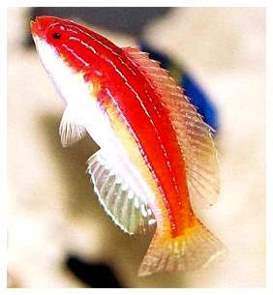 |
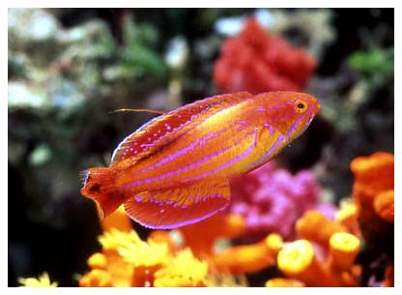 |
|
Figures 7 & 8. Paracheilinus attenuatus,
female (left), and male in display (right) from Kenya.
Note the short filamentous tip on the center of the
dorsal fin (left fish). Right photo by Takeshi Aoki.
|
I obtained males of P. cyaneus (the Blue Flasher Wrasse;
Figures 9, 11 & 17)
for the first time from a Japanese friend/shipper in Bali
in 1997, when the species had yet to be named. They were still
young (all were 5 - 6 cm in length) but had several long filaments
on their dorsal fin. They were sold to me as P. filamentosus
but I was astonished to discover that they were actually P.
cyaneus after publication of the species from Indonesia
and Western Australia in 1999 (Kuiter & Allen). Males
of P. cyaneus, however, can be distinguished from P.
filamentosus by the many fine dots on their side and also
their back is often greenish (Figure 17).
Prior to 2004, the species could be seen in stores only on
rare occasions, but now it is readily available and some reach
a size of nearly 8cm long.
Another common species from northern Indonesia, P. lineopunctatus
(the Line-spot Flasher Wrasse; Figures 10 & 12 below),
is not a close relative of P. cyaneus, but appears
very similar when they are displaying. The latter, however,
has a rounded caudal fin.
|
Figures 9 & 10. A P. cyaneus, young
male (left) and a P. lineopunctatus, male (right),
with their unexciting colorations.
|
|
Figures 11 & 12. Two males, P. cyaneus
(left) and P. lineopunctatus (right), displaying
their colors. Note the beautiful blue band at the base
of the dorsal fin and the red blotch on the fish to
the right.
|
Paracheilinus rubricaudalis, the Red-tailed Flasher
Wrasse (Figures 13 & 14 below), is the newest member
imported from Fiji and Vanuatu and was not described until
2003 (Randall & Allen). It is somewhat larger than P.
mccoskeri, its close relative, and will reach almost 9
cm in length. They are shipped only from Vanuatu on rare occasions,
and remain expensive. The species has a red tail and a broad
red zone with a single filament on its dorsal fin. Males have
a reddish area on their distal anal fin. The reddish stripes
on their sides turn whitish and their body becomes bright
yellow while they are displaying. Males from Fiji have a narrow
bluish vertical stripe on their caudal fin that is never seen
on specimens from Vanuatu.
|
Figures 13 & 14. Paracheilinus rubricaudalis,
the same male, colors of display (right).
|
|
Figures 15 & 16. A P. angulatus (left)
and P. filamentosus (right), both males. These
are often shipped from the Philippines or Indonesia.
|
|
|
|
Figure 17. Males of P. filamentosus (upper)
and P. cyaneus (lower).
|
Paracheilinus angulatus (the Angular Flasher Wrasse;
Figure 15 above), P. filamentosus (the Filamented
Flasher Wrasse; Figures 16, 17 & 18) and P. octotaenia
(the Red Sea Flasher Wrasse; Figure 19)
are now available on a regular basis in the trade, but the
last one still is somewhat rare due to its distribution from
the Red Sea. Paracheilinus angulatus is characterized
by sharply pointed dorsal and anal fins with no filament,
and also by an emarginate
caudal fin. It is regularly available but is never included
in shipments from some areas of the Philippines, suggesting
either that the species does not inhabit some specific areas
within its range or that collectors in the area do not get
orders for it or know of it. Paracheilinus angulatus,
a rare species, is somewhat similar in appearance to P.
togeanensis but is distinguished by its rounded dorsal
fin.
Paracheilinus
bellae, which I have never seen sold in the trade,
is very similar to P. filamentosus with which it co-exists.
Paracheilinus bellae has a distinct yellow area on
the center of its caudal fin while males of P. filamentosus
have five to seven filaments on their dorsal fin and also
lines on their side, but are plain between the lines.
Paracheilinus togeanensis is a true rarity; only a
few have been sighted in and collected from their natural
habitat in Sulawesi, Indonesia. An excellent underwater photo
of a pair was shown as P. angulatus on the US
FishBase website, but it has been deleted from the website
since I pointed out they were actually specimens of P.
togeanensis. I had no idea why the picture was not shown
in the P. togeanensis section, but soon realized that
they do not intend to show it because no one knows who took
the photo!
|
Figure 18. A P. filamentosus male demonstrating
its display coloration.
|
|
Figure 19. A P. octotaenia, male, from
the Red Sea. A very outstandingly-shaped species due
to its rounded caudal fin that easily distinguishes
it from its relatives.
|
Several popular species are commonly misnamed, including
the well-known "Pink Flasher" that is similar to
P. carpenteri and other similar looking hybrids as
well (e.g., P. flavianalis x P. filamentosus,
etc.). Additionally, sometimes I find unusually shaped or
colored specimens that are not typical of any valid species.
I suspect that these are naturally hybridized specimens, and
they often are observed by divers, especially around famous
diving sites in Indonesia and the Philippines. These areas
are the homes of many Paracheilinus and they often
mix in the same localities. In my experience, the hybrid of
P. filamentosus x P. flavianalis (Figure 20
below) is the most abundant in the aquarium trade.
The hybrids possess elements of both parents that can be readily
seen, especially in their caudal-fin's shape and filaments.
Also, a careful observation of the dorsal and anal fins' coloration
could determine the parent species of the individual, and
parental species' distributions may also provide an important
hint (Kuiter & Allen 1999).
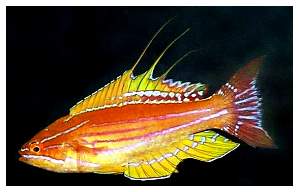 |
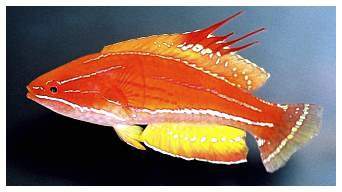 |
|
Figures 20 & 21. Two possibly hybridized
male specimens, P. filamentosus x P. flavianalis
(left; the anal fin is damaged), and P. carpenteri
x P flavianalis (right). The latter probably
reproduced in a small area of Indonesia's northern limit
or the southern end of the Philippines if my memory
is correct.
|
Paracheilinus hemitaeniatus (the Half-banded Flasher
Wrasse) and P.
piscilineatus (the Elegant Flasher Wrasse) are restricted
to small areas of the western Indian Ocean. Paracheilinus
hemitaeniatus is not available in the trade, and P.
piscilineatus is extremely rare in the trade; I have never
seen one offered for sale. I know that several "undescribed"
species remain in the field that are known from various, but
small, localities in the Pacific Ocean, including Iriomote
(Japan), the Great Barrier Reef (Australia), Palau, Samoa
and the Philippines. I hope that these will soon be collected
by extensive diving and named by ichthyologists.
Flasher Wrasses in the Aquarium
The flasher wrasses are plankton feeders
and are very easy to feed in the captive environment. They
feed well on variety of foods including wet or freeze-dried
brine shrimp, flake foods, fresh small clams and a variety
of other meaty foods. With proper care, they can live long
in captivity. Remember, however, that they can be jumpers
in non-covered tanks and need many crevices for hiding and
also plenty of open space to swim freely. For adult flasher
wrasses a tank size of at least 60 x 30 x 30 cm should be
sufficient, but juveniles can be kept in smaller aquariums.
Unlike some other wrasses that sleep in the sand, they do
not need a sand bed as flasher wrasses create a mucus cocoon
over their bodies for sleeping. They generally require the
same care as the related fairy
wrasses. If you are lucky enough to find several individuals
of the same species at a retailer, you should choose the largest
specimen first and then select other, smaller males or females.
Introduce all of them into the tank at the same time or release
the younger or smaller specimens first in order to minimize
the larger fish from picking on the smaller ones. They can
be kept along with other Paracheilinus males and/or
females of any species as well as Cirrhilabrus species
in the same tank. Of course, you may have a single individual
in a tank that can live longer than its tankmates, but if
you want to see their flashing behavior, I recommend keeping
as many specimens as possible, especially males. They generally
do not harm the typical invertebrates kept as display organisms,
and they easily adapt to reef systems. Flashers can be kept
with smaller angelfishes such as Centropyge, non-aggressive
damsels, wrasses of different genera, cardinalfishes, seahorses
and pipefishes, butterflyfishes, and other non-aggressive
fish. Paracheilinus males may fight, but usually this
does not cause any serious damage; although if one continues
to hide or retire you may want to remove the weakest or the
strongest, and keep it in a separate tank for several weeks.
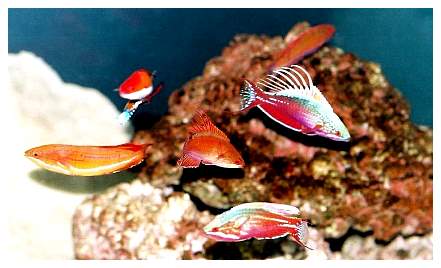 |
|
Figure 22. In my own tank I enjoy a collection
of fairy and flasher wrasses with great pleasure, although
the background is very simple with no colorful live
coral.
|
Acknowledgement:
Many thanks to Takeshi Aoki who provided his male Paracheilinus
attenuatus photo that made this article more colorful
and accurate.
|

